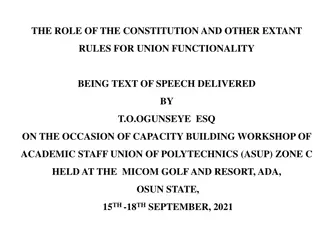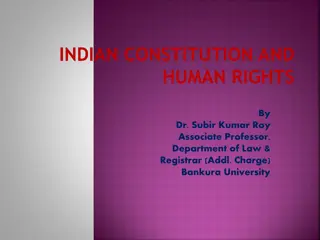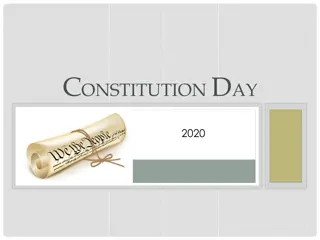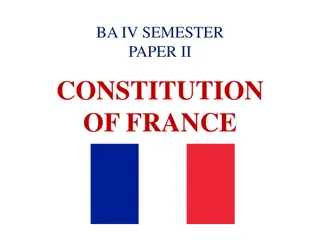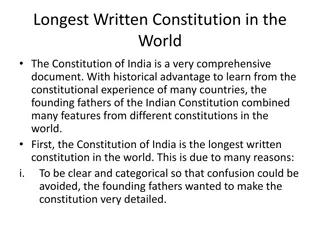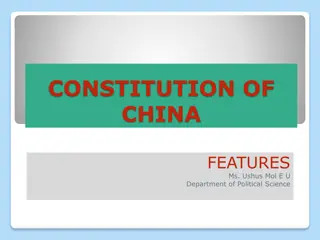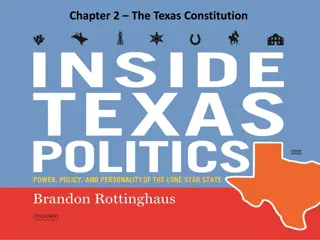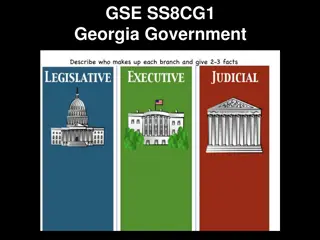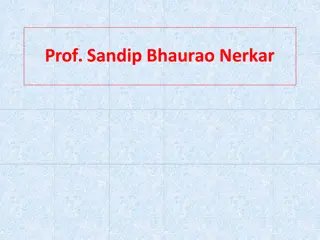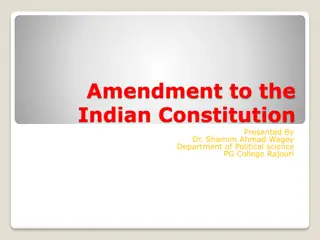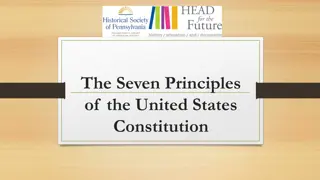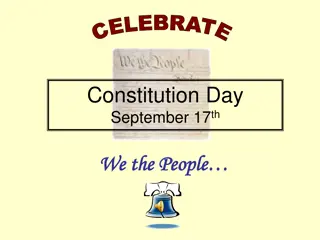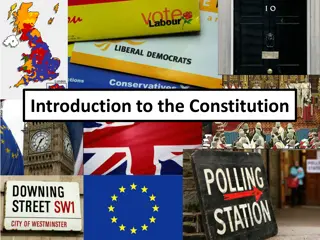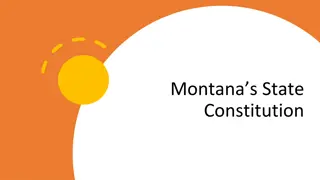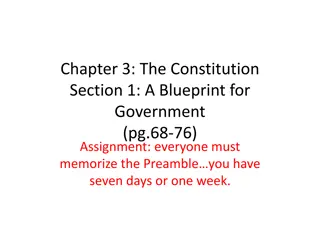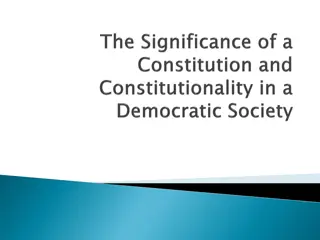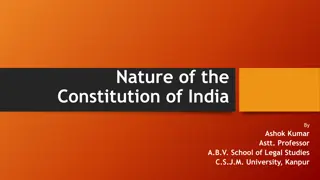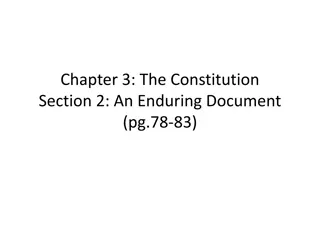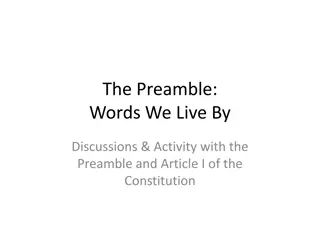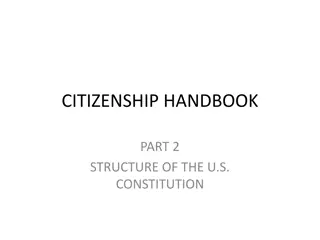Understanding the Seven Principles of How the Constitution Works
Explore the seven principles of the Constitution through visual metaphors, learning about popular sovereignty, republicanism, federalism, separation of powers, and more. Enhance your understanding of how the Constitution functions in governing society.
Download Presentation

Please find below an Image/Link to download the presentation.
The content on the website is provided AS IS for your information and personal use only. It may not be sold, licensed, or shared on other websites without obtaining consent from the author. Download presentation by click this link. If you encounter any issues during the download, it is possible that the publisher has removed the file from their server.
E N D
Presentation Transcript
Learning Objective: 1. Students will create visual metaphors to explain the seven principles of the Constitution. 2. Students will practice their speaking skills as they explain their visual analogies to the rest of the class.
Wednesday, September 16th BELLRINGER If you had to chose 7 major themes or elements the constitution needed to include, what would they be?
DRAW CHART BELOW 7 Principles Of the Constitution
7 Principles Chart Write name of principle in one section of chart and write text in red from each slide
Popular Sovereignty Definition The belief that people can and should govern themselves; the people rule. Example People can run for office, campaign for individuals who run, or protest decisions made by others. Rule is not passed down based on blood line, or military coup. http://t3.gstatic.com/images?q=tbn:ANd9GcRxX4nODoX6Ijb-rBIZprspX7h2ZyTRjn3m1Y7CEMI6FPcOMlrH
Republicanism Definition People vote for people to represent their views in government. (Representative Government) You can t have the whole population vote on everything, so you vote on people who share similar beliefs and allow them to vote. Direct election of Senators and Representatives.
Federalism Definition Power is shared by the state and federal government. In our system, the national government does have ultimate authority, but states have a lot to say in what goes on as well. Powers for the national government = delegated powers, Powers for the state government = reserved powers, Powers shared between the national and the state are concurrent powers.
Separation of Powers Definition The Federal government is divided into 3 branches - Executive, Legislative, and Judicial. This system prevents any one branch from gaining too much power and turning the country towards tyranny. Remember Charles de Montesquieu!
Checks and Balances Definition Each of the 3 branches of government has a check on the other 2 branches. This balances power between the 3, ensuring that none of the branches seizes control. Example Federal judges are nominated by the President, but have to be approved by Congress. Bills must be passed by both houses of the legislative branch, signed by the president, and can even be challenged in the courts.
Limited Government Definition Everybody has to follow the same laws, even members of the government. If a Representative committed a crime, he/she would face a trial just like everybody else.
Individual Rights Definition Personal liberties (Unalienable Rights) and privileges that people are born with and can not be taken away. The Bill of Rights, the first Ten Amendments, was created to specifically ensure the rights of the people.
ASSIGNMENT Each group will take a closer look at one particular principle and will visualize it in an Illustrated Metaphor. Each group will get a card and read and discuss their principle. You will brainstorm ideas on ways to draw your principle into an illustrated analogy or metaphor using symbols and labels. Once you are ready, you may use the butcher paper to illustrate your principal in a way that will help explain it to others in your class. Be sure to label your principle on your poster.
POPULAR SOVEREIGNTY We the People Our Constitution begins with the idea of popular sovereignty. The Founding Fathers began the U.S. Constitution with this important principle, which means that power, begins with the people. This principle is best reflected in the Preamble, Article I and in Amendment 9. Popular sovereignty is the thought that the average citizen can be trusted to make important decisions that affect his or her life and the lives of other Americans. Throughout American history, more and more citizens were permitted to participate in the democratic process. The idea that power can begin from the ground up; that a group of people can exercise that power and change their society for the better is an exciting idea in human history. Illustrated Metaphor To help with your drawing, imagine something small and weak, but when this small being joins up with many other small beings, they can become a large and powerful force.
FEDERALISM The Founders looked to their local state governments to best govern over their own local needs. At the same time they recognized the need for a strong, national government that would protect them and help regulate their commerce. The solution was the balance of federalism. Federalism is the sharing of powers between the state governments and the national government. When the Founding Fathers wrote the U.S. Constitution, one of their challenges was creating a strong national government, which at the same time respected the rights of the state governments. How did they ensure that one did not trample onto the other? The Constitution states that the federal government has specific powers such as coining money or defending the country. At the same time, the state governments also have powers that are reserved to them, such as creating schools. Finally there are powers they share such as the power to tax. Illustrated Metaphor - To help with your drawing, imagine two separate, different objects that still share something in the middle.
REPUBLICANISM Another idea that the Framers of the Constitution agreed upon was the idea that citizens should be able to elect their leaders. In a republic, the citizens vote for what or whom they think will be best for the general public good. This principle of the Constitution is not to be confused with the Republican political party, which shares a similar name. To help you remember what republicanism means, take the first 3 letters of the word, R-E-P and use it to remind yourself of the word REPRESENTATIVE. Voters choose representatives to exercise the power that they give to them. Republicanism is best found in the Preamble and in Article I of the Constitution. Illustrated Metaphor To help with your drawing, imagine someone temporarily handing over power to someone else. They are to be trusted to make decisions for the general good of all.
SEPARATION OF POWERS This principle of the U.S. Constitution divides powers into three separate groups or branches of government. The reason the Framers chose this was because they wanted to ensure that no one person or group of people had too much power. Their idea originated from the way the English government had developed into three separate groups: the monarchy, the House of Lords and the House of Commons. Instead the U.S. Constitution divides power into the executive branch, the legislative branch and the judicial branch. Each branch has its own unique responsibilities and powers, including powers over the other branches. These branches are described in Articles I, II and III. Illustrated Metaphor To help with your drawing, imagine something that has three different parts, each with its own unique characteristics, yet still a part of the whole.
CHECKS & BALANCES This principle of the Constitution is closely connected with Separation of Powers. The Founding Fathers wanted to make sure that the three different branches of government, the legislative, executive and judicial, would be able to limit each other s powers. In this way they control certain powers as well as share other powers with them. For example, the President can appoint ambassadors or federal judges, but only with the approval of the Senate, the upper house of Congress. You will find the principle of Checks & Balances throughout Articles I, II, and III. This is a very important way to protect the citizens liberties and ensure that no one group of people becomes too powerful. Each branch always has the other two branches looking over their shoulder. Illustrated Metaphor - To help with your drawing, imagine a product or process that doesn t work unless several keys are turned or buttons are pushed, each being a separate branch checking the powers of the other. Or imagine a person or animal that starts something but is quickly put back into line by another person or animal.
LIMITED GOVERNMENT The idea of Limited Government can be traced in English history back to the Magna Carta, when the nobles first restricted the power of the King in 1215. When the Founding Fathers wrote the U.S. Constitution they recognized the need to express that the government s powers were limited. Government leaders could not abuse their powers; they were not above the law. This was an important step in ensuring that the citizens liberties were protected. The principle of Limited Government can be found in Articles I, II, III. Illustrated Metaphor - To help with your drawing, imagine something or someone that is being restricted or told no. They are not more special than everybody else.
INDIVIDUAL RIGHTS In the Preamble of the Constitution it states to secure the blessings of liberty to ourselves and our posterity This principle guarantees that citizens possess basic rights and liberties. This idea can be traced back to Thomas Jefferson s quote on, life, liberty and the pursuit of happiness in the Declaration of Independence, borrowed from the philosopher John Locke. Locke had argued that all human beings were born with three natural rights, life, liberty and property and the purpose of government was to protect those rights. The Founders debated the best way to do that, but in the end, the Constitution was amended to include the protection of certain rights, which can be found in the Bill of Rights. Illustrated Metaphor To help with your drawing, imagine something or someone who can do something because they have a permission slip.
1. How does the Constitution reflect the democratic principle of popular sovereignty? 2. Which principle protects the right of the people to decide about issues by voting?


